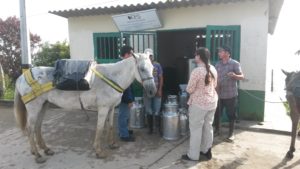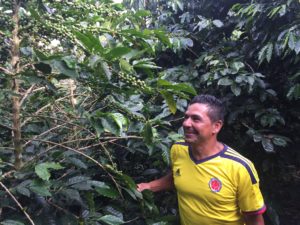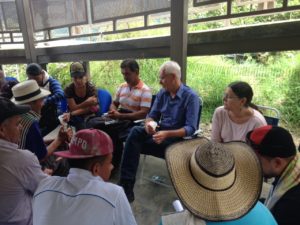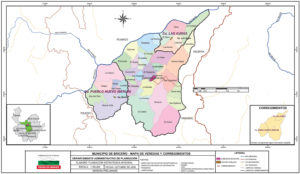
Getting to the Briceño region in the heart of Antioquia requires an excellent vehicle, and a lot of time and luck. The week before our journey there in mid-July, heavy rains wiped out part of the road between Briceño and Pueblo Nuevo, stranding folks on one side or the other. We were lucky on the day of our journey – no rain. But it took a six-hour drive to get from Medellín to Briceño, and another three hours of sometimes harrowing curves to Pueblo Nuevo. The dirt-road drive itself was a stark reminder of the challenges Colombia faces as it seeks to eliminate 50,000 hectares of coca this year through the crop substitution program, Programa Nacional Integral de Sustitución de Cultivos de Uso Ilícito (National Comprehensive Program for the Substitution of Illicit Crops), known by the acronym PNIS.
The PNIS is at the heart of point four of the peace accord signed between the government and the FARC, the part that pledges to bring a “Solution to the Illicit Drugs Problem” and to eliminate the illicit cultivation of coca, cannabis, and opium poppy. The government is signing accords at the community level as well as with individual families, in which the farmers commit to “voluntarily” eradicate their coca in exchange for immediate cash compensation during the first year and small project investments in the second year. The accords delineate that each farmer will receive a total of 36 million pesos spread over two years (about US$12,000), and also serve as a government promise to invest in transforming these rural economies in the longer term. About a month before our visit to the Briceño region, about 650 families had each received two million pesos (about US$675) for the first two months, which set the clock ticking. They then had 60 days to uproot their coca bushes (no easy task) or lose their right to receive any further development assistance and potentially face criminal prosecution.
There is no doubt in our minds that the peace accord marks an extremely significant historical moment and has raised genuine hopes for reducing the endemic human rights violations, violence, and conflict in Colombia. Moreover, the peace accord is built on two important pillars: community participation and the transformation of rural economies, recognizing that poverty, social exclusion, and violence are what have fueled the spread of coca cultivation across the country. The accord aspires to “construct a stable and long-lasting peace,” which requires a solution of equitable rural development in some of the most abandoned regions of the country.
Nonetheless, our trip to Briceño illustrated the tremendous challenges that the government and the FARC face as they move forward with implementing the peace accord and in particular, the coca substitution program. We were invited by Pedro Arenas of the Observatorio de Cultivos y Cultivadores Declarados Ilícitos (OCCDI), an organization supported by TNI and WOLA from its initiation, to accompany an on-the-ground verification mission and to witness the progress made and the difficulties encountered.
Just over a year ago, the government launched the first crop substitution project in Briceño with the hopes of achieving quick results to build political support for the effort. One significant development was the construction of a bridge that eliminates the need to drive through a river on the drive from the town of Briceño to the small hamlet of Pueblo Nuevo – though it’s still far from a smooth ride to even get to the new bridge. There is also a brand-new and well-equipped library in Pueblo Nuevo, as well as some improvements planned for a few local schools.

New bridge connecting Briceño and Pueblo Nuevo.

Old bridge connecting Briceño and Pueblo Nuevo.
While coca dominates the local economy, some income generation has been obtained through milk and coffee production, which could provide interesting alternatives for the PNIS. In terms of milk, communities (with international support) have installed refrigerated containers where cooperative members can store their milk before it is transported to buyers.

Discussing milk production and economy in Briceño.
Coffee may be even more promising. Ómar Jiménez proudly showed off his small coffee farm in the town of Las Auras. Fed up with the violence (paramilitaries killed numerous family members, including his mother) and in the face of threats by coca paste buyers, Ómar says he pulled out his coca plants some 7 years ago and began growing coffee. It turns out that the soil in that part of the country produces a rich coffee bean; he eventually beat all of the country’s better-known coffee companies in a blind tasting and has just begun very modest exports to Europe. A visit to a coffee shop in the town of Briceño provided ample evidence of the quality of the coffee being produced by Ómar and his associates from ASDESEBRI (Association for the Productive, Economic, Social and Ecological Development of the Briceño Municipality).

Ómar with his coffee plants.
Ómar is trying to convince others that the switch from coca to coffee can pay off. However, it is a tough sell in an area where coca grows visibly across the hillsides and is easy to transport and sell.

Hillside covered in coca.

Eradicated coca.
We managed to speak with all parties involved, including the municipal Peace Office. In a meeting with a group of community leaders from 11 of the 13 towns involved in the Briceño crop substitution project, we heard a litany of concerns, ranging from the practical to the already evident bottlenecks in transforming their local economy.
Pulling out coca bushes by the roots, as demanded in the agreements, is hard work, especially those bushes that are several years old. One burly young man told us that he spent two hours trying to pull out one plant –and had almost succeeded– while one hectare can have as many as 10,000 bushes. The government originally said that coca harvesters (raspachines or recolectores) would be contracted to carry out the physical labor. But an agreement has yet to be reached in Bogotá as to how this would work in practice, and apparently now resides in the hands of the Ministry of Labor.
The people we spoke to were happy to have received their first cash payment. Many used it to pay off debts, shore up their houses or buy clothes for their kids – and a lot of it was spent on booze in the days after the money was handed out. Indeed, the women community leaders we spoke to were particularly upset about the lack of a gender focus in the program. Many women in the area cultivate a plot of coca for themselves in order to have some autonomy from their husbands. “In the least,” one woman said, “the money should be split evenly between husband and wife.” In addition to the need for a differentiated approach for women coca growers, in collective territories, consultation with ethnic minorities is crucial

Meeting with community leaders.
But as the cash was being doled out, no technical assistance was evident. There was surprisingly little discussion of what products could quickly replace the income generated by coca.
“Some people say they want to produce eggs,” lamented Beatriz Jaramillo. “But if someone gets 200 chickens and doesn’t know how to take care of them, the project isn’t going to bear fruit. And how are they going to get those eggs to market on these roads?” One man complained that he had repeatedly brought up the issue of off-farm employment, but was told, “that isn’t part of the program.”
Concerns about the lack of roads and infrastructure, and hence the tremendous difficulty of transporting alternative crops, as well as the lack of viable markets, were themes we heard repeatedly.

Issues of personal safety also came up frequently. There are already reports of unknown individuals coming into the communities – like Briceño – where the FARC has pulled out, presumably coca paste buyers employed by other armed groups or criminal gangs. The Defensoría del Pueblo has confirmed that there have been threats and assassinations of social leaders involved in substitution programs.
Finally, local residents are deeply concerned that they will eliminate their primary source of cash income and the government will fail to deliver on what it has promised. “We’ve had many international visitors come through our little towns,” said one woman. “But we know that they will leave and the government will leave, and in the end, we will just have to fend for ourselves.” With the 60-day deadline fast approaching and with some farmers having started to pull out their coca, many are still reluctant to eradicate everything amidst so many insecurities.
Requests for a more gradual reduction of coca plants in parallel with the creation of alternative sources of income have been denied, however, as the peace accord spells out: “Coexistence between being a beneficiary of a substitution program and being linked to economies related to crops used for illicit purposes is not acceptable,” (4.1.3.2) and that PNIS support “will be conditioned on compliance with the schedule of commitments made by growers in the agreements on substitution and refrainment from replanting” (4.1.3.6 a). In addition, the contract signed by each family – none of them had yet received a copy, in spite of multiple requests – clarifies that noncompliance with the 60-day deadline immediately results in withdrawal from the PNIS program and forfeiture of any future development assistance. As any contract requires reciprocity, however, the exception is in the case of “noncompliance from the side of the government.”
Just prior to our Briceño visit, the UN Office on Drugs and Crime (UNODC) released its 2016 coca cultivation statistics which revealed a 52% increase over the previous year: from 96,000 hectares in 2015 to 146,000 in 2016. While the increase came as no surprise, it has put pressure on the government to achieve quick results through forced eradication. Reports began proliferating of forced eradication and violent confrontations between eradicators and the local population in areas where communities have already signed crop substitution agreements. These operations aim to eliminate another 50,000 hectares before the end of the year, but are also meant to keep alive a real threat: the classic carrot-and-stick approach. For the communities in Briceño that threat is very credible indeed, as an army battalion is already stationed there and military posts have also been established in the townships of El Roblal and Pueblo Nuevo. However, confidence in a supposedly voluntary substitution program based on the principle of community participation cannot be built on threats.
The Colombian government faces a tremendous challenge in building trust amongst communities that have been neglected for decades and have suffered bad experiences with previous broken pacts. In addition, implementing a highly complicated process with scarce resources and limited capacity, while under political pressure to show quick results, is not an easy undertaking. This is especially challenging in the midst of conflicting agendas between the different state agencies and under strong pressure from the U.S. government. In a testimony to the U.S. Congress on August 2nd, William Brownfield, Assistant Secretary of State for the Bureau of International Narcotics and Law Enforcement Affairs, stressed the need of “overcoming the persistent social protests that disrupt forced eradication operations. Without a permanent solution to the social protest issue, forced eradication efforts are unlikely to have a significant effect on coca cultivation levels in 2017…Voluntary eradication agreements must also have expiration dates so the security forces can forcibly eradicate in farms where coca growing communities fail to meet their obligations.”
We left Briceño at night to keep ahead of the expected rainfall, thus avoiding the risk of being trapped, even though the thought was attractive, as we would have loved to have stayed longer amongst the many friendly and courageous people we had met. We left impressed by their commitment to support the peace process, but also worried about the difficult choices they face and the troubled times that may lie ahead for them and their families. So, let us end here with some suggestions of what we think would most benefit the people of Briceño during this crucial moment:
[1] Martin Jelsma is the Director of the Drugs & Democracy program at the Transnational Institute (TNI) and Coletta Youngers is a Senior Fellow at the Washington Office on Latin America (WOLA).